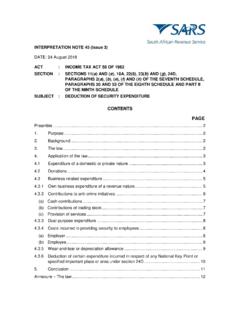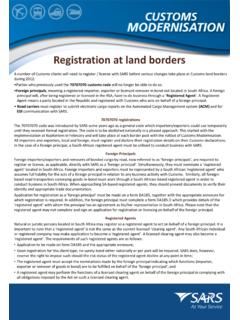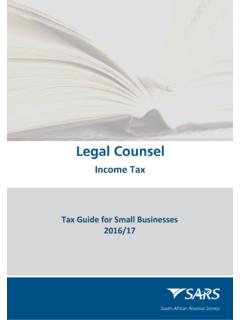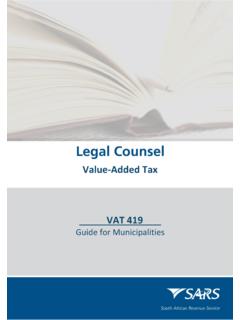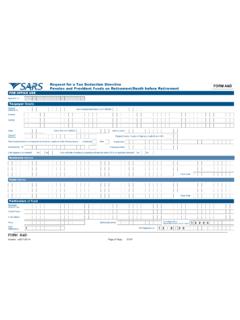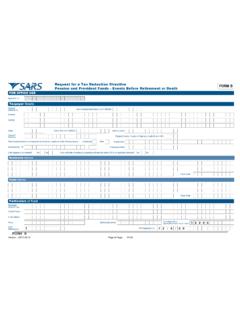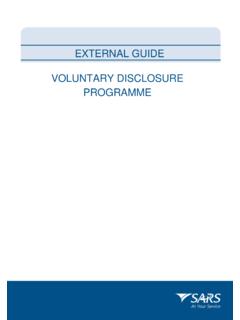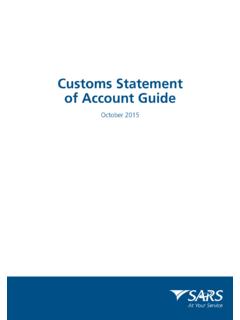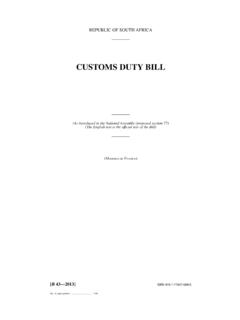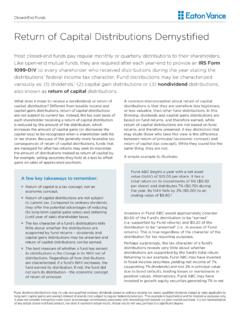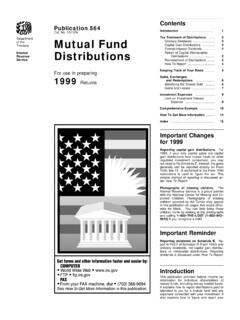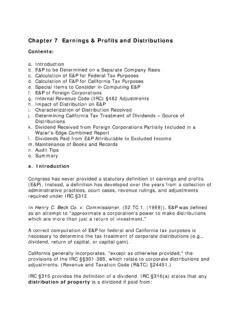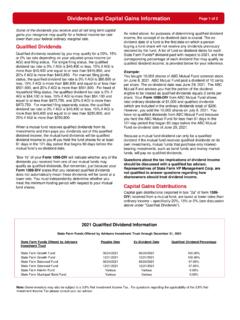Transcription of DT-GEN-01-G03 - A Quick Guide to Dividends Tax - External ...
1 External Guide A Quick Guide TO Dividends TAX External Guide A Quick Guide TO Dividends TAX DT-GEN-01-G03 REVISION: 2 Page 2 of 10 TABLE OF CONTENTS 1 INTRODUCTION 3 2 MAIN DIFFERENCES BETWEEN SECONDARY TAX ON COMPANIES AND Dividends TAX 3 3 RATE 4 4 TAX LIABILITY 4 5 WITHHOLDING TAX 4 6 EXEMPTIONS 4 7 REDUCED RATES FOR FOREIGN RESIDENTS 5 8 LEVYING THE TAX 5 9 SECONDARY TAX ON COMPANIES (STC) CREDIT 6 10 DUAL LISTED COMPANIES 6 11 Dividends TAX TRANSACTIONAL DATA 6 12 CHANNELS FOR SUBMISSION 7 13 PAYMENTS, RECOVERY AND ADMIN 7 PAYMENT OF LIABILITY 7 RETURNS 8 REFUNDS UNDER THE Dividends TAX DISPENSATION 8 OTHER 8 14 Dividends TAX PAYMENT PROCESS AT A GLANCE 8 15 GLOSSARY OF TERMS 9 External Guide A Quick Guide TO Dividends TAX DT-GEN-01-G03 REVISION: 2 Page 3 of 10 1 INTRODUCTION In 2007, the Minister of Finance announced that Secondary Tax on Companies (STC) would be replaced by Dividends Tax.
2 The legislative foundation for the new Dividends Tax is to be found in sections 64D to 64N of the Income Tax Act, 1962 (the Act), and became effective on 1 April 2012. The main objectives behind the change to Dividends Tax were to: Align South Africa with the international norm where the recipient of the dividend , not the company paying it, is liable for the tax relating to the dividend (with STC South Africa was one of a handful of countries with a corporate level tax on Dividends ). Make South Africa a more attractive international investment destination by eliminating the perception of a higher corporate tax rate (STC is an additional corporate tax) coupled with lower accounting profits (STC has to be accounted for in the Income Statement).
3 In simple terms, Dividends Tax is a tax imposed on shareholders on receipt of Dividends , whereas STC is a tax imposed on companies on the declaration of Dividends . The Dividends Tax is a withholding tax as it should be withheld and paid to SARS by the company paying the dividend or by a regulated intermediary ( a withholding agent interposed between the company paying the dividend and the beneficial owner), and not the person liable for the tax ( the beneficial owner of the dividend ). 2 MAIN DIFFERENCES BETWEEN SECONDARY TAX ON COMPANIES AND Dividends TAX SECONDARY TAX ON COMPANIES (STC) Dividends TAX Underlying theory Movement of an amount representing a profit / reserve to a shareholder outside company / group should attract tax Payments/distributions (less CTC) to beneficial owners should attract tax (Deemed Dividends are an exception to this rule) Trigger Declaration or Deemed declaration Listed shares: actual payment Unlisted shares: actual payment or date due and payable (whichever is first) Dividends in specie.
4 Actual payment or date due and payable (whichever is first) Debt owing to company during year (low / no interest): last day of the year of assessment Liability for tax Company Beneficial owner: Normal / cash Dividends Company: In specie Dividends (including deemed Dividends ) Counter parties Company vs. Shareholder Company vs. Beneficial owner (with the Withholder interposed) External Guide A Quick Guide TO Dividends TAX DT-GEN-01-G03 REVISION: 2 Page 4 of 10 3 RATE The Secondary Tax on Companies rate was 10% at the time it was replaced with the Dividends Tax.
5 Unless one of the exemptions or a reduced rate is applicable, the Dividends tax rate is: 15% if the dividend was paid/payable before 22 Feb 2017; and 20% if the dividend is paid/payable on or after 22 Feb 2017 4 TAX LIABILITY The liability for Secondary Tax on Companies is triggered by declaration of a dividend , falls on the company declaring the dividend , and is payable on top of the dividend distributed. In contrast thereto, as a general principle, the liability for Dividends Tax is triggered by payment of the dividend , falls on the recipient ( beneficial owner) of the dividend , and is to be withheld from the dividend payment by either the company distributing the dividend or, where relevant, certain other withholding agents.
6 Dividends in specie is an exception to this general principle as the liability for the Dividends Tax falls on the company paying the dividend (as under STC), and is not transferred to the recipient. Further, there are certain transactions that are deemed to be Dividends for purposes of the Dividends Tax (such as where low/no interest is charged in respect of a debt that arose by virtue of a share held in the company (see section 64E(4)); as well as certain cessions, share borrowings and share sales (see section 64EB)).
7 5 WITHHOLDING TAX Dividends Tax is a withholding tax and should be withheld from dividend distributions and paid to SARS by the company paying the dividend or, where a regulated intermediary is involved, by the latter. The person liable for the Dividends Tax retains the ultimate responsibility to pay the tax should any of the withholding agents fail to withhold. 6 EXEMPTIONS Under Secondary Tax on Companies the Dividends declared by certain companies were exempt based on the status of the declaring company (section 10 exempt entities; fixed property companies; certain gold miners; intra-group; tax holiday companies and/or registered micro businesses).
8 Under Dividends Tax the dividend payments could be exempt from Dividends Tax depending on the nature or status of the recipient. The exemptions are elective in the sense that it will only apply where the company distributing the dividend or regulated intermediary receives the required notifications ( declaration and undertaking in the form prescribed by SARS) from the recipient prior to payment of the dividend . The recipient needs to submit both of the following: Declaration by Beneficial Owner Undertaking by Beneficial Owner to inform SARS of future changes Withholding / Payment to SARS Company Company Regulated intermediary External Guide A Quick Guide TO Dividends TAX DT-GEN-01-G03 REVISION: 2 Page 5 of 10 Where the notifications as indicated are not submitted in time the withholding agent is required to withhold tax at the full rate.
9 However, under these circumstances the beneficial owner has three years to submit the required notifications and claim a refund from the person who withheld the Dividends Tax from the dividend payment. Examples of exempt entities are local companies; any of the three tiers of government; approved public benefit organisations (section 30(3) of the Act); mining rehabilitation trusts (section 37A of the Act); persons referred to in section 10(1)(cA) of the Act; pension, provident, preservation, retirement annuity, beneficiary and benefit funds (section 10(1)(d)(i) and (ii) of the Act); persons referred to in section 10(1)(t) of the Act (CSIR, SANRAL etc).
10 Shareholder in a registered micro business (6th Schedule of the Act) insofar as the dividend does not exceed R200,000 per annum; non-resident beneficial owners of Dividends received from SA listed non-resident companies; portfolio of a collective investment scheme in securities; any person insofar as the dividend constitutes income of that person; any person insofar as the dividend was subject to STC; fidelity or indemnity funds (section 10(1)(d)(iii)); and a natural person/deceased estate/insolvent estate insofar as the dividend is paid in respect of a tax free investment (section 12T(1)).
